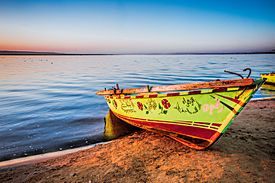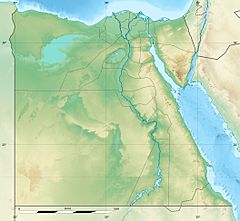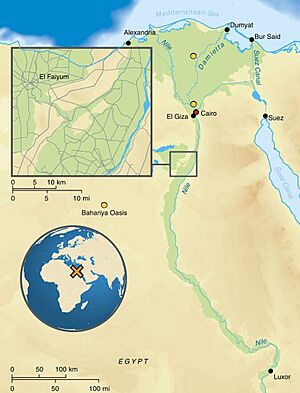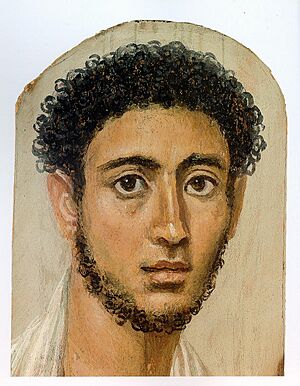Faiyum facts for kids
Quick facts for kids
Faiyum
الفيوم
|
|
|---|---|
|
Clockwise from top:
a fishing boat on Lake Qarun, Whale Valley, trees fighting desertification, Sobek Temple |
|
| Country | Egypt |
| Governorate | Faiyum |
| Area | |
| • Total | 18.5 km2 (7.1 sq mi) |
| Elevation | 29 m (95 ft) |
| Population
(2021)
|
|
| • Total | 519,047 |
| • Density | 28,060/km2 (72,670/sq mi) |
| Time zone | UTC+2 (EET) |
Faiyum (pronounced fy-YOOM) is an ancient city in Middle Egypt. It's located about 100 kilometers (62 miles) southwest of Cairo, in the Faiyum Oasis. Faiyum is the capital of the modern Faiyum Governorate. It is one of Egypt's oldest cities because of its important location.
Contents
What's in a Name?
Faiyum has had many names throughout history! The ancient Egyptians first called it Shedet. Today, you might see it spelled as Fayum, Faiyum, or al-Faiyūm. Sometimes, the name Faiyum can also refer to the entire Faiyum Oasis, not just the city.
The name Faiyum comes from an old Egyptian word, pꜣ-ym, which means "the Sea" or "the Lake". This name refers to the nearby Lake Moeris.
Ancient History of Faiyum
People have lived in the Faiyum area for a very long time, even before recorded history! Scientists have found evidence of people living here at least since the Stone Age.
Crocodile City
Around 2685 BC, during Egypt's Old Kingdom, a settlement called Shedet was built. This city was very important for the worship of the crocodile god, Sobek. Because of this, the ancient Greeks later called the city "Crocodile City" (Krokodeilópolis).
The people of Crocodile City even had a special, tamed crocodile named Petsuchos. This sacred crocodile lived in a temple pond. Priests would feed it food brought by visitors. When one Petsuchos died, another crocodile would take its place.
Renamed by Rulers
Later, under the Ptolemaic Kingdom, the city was renamed Arsinoë. This was done by Ptolemy II Philadelphus to honor his sister-wife, Arsinoe II. She was considered a goddess after she died. Ptolemy II also built a new town nearby called Philadelphia. It was designed like a Greek city with homes, palaces, baths, and a theater.
When the Roman Empire took over, Arsinoë became part of a Roman province. To tell it apart from other cities with the same name, it was called "Arsinoë in Arcadia".
Famous Mummy Portraits
Faiyum is famous for its unique Fayum mummy portraits. These are paintings of people's faces found on ancient Egyptian mummy cases. Even though the Romans preferred to burn their dead, Egyptians continued to bury them.
These portraits were painted on wood using a special wax technique called encaustic. For a long time, people thought these portraits showed Greek settlers in Egypt. However, modern studies suggest they mostly show native Egyptians. This shows how Egyptian culture mixed with the Greek culture of the ruling class.
The Zenon Papyri
We know a lot about the building of Philadelphia thanks to a Greek official named Zeno. He worked for the finance minister of Ptolemy II Philadelphus. Zeno wrote detailed notes about the construction of buildings like theaters and palaces in the 250s and 240s BC. He also recorded many legal and money deals between people.
In 1914, over 2,000 papyrus documents were found by Egyptian workers. These documents turned out to be Zeno's records, written in Greek. These papers, called the Zenon Archive, give historians a detailed look into the society and economy of Philadelphia in the 3rd century BC.
Faiyum Today
Faiyum is a busy city with large markets and many mosques. A canal called Bahr Yussef flows through the city, with houses built along its banks. There are two bridges over the canal. One bridge carries the main street and market. The other bridge has the Qaitbay mosque built on top of it. This mosque was a gift from the wife of a Mamluk Sultan.
The city's center is known for its four waterwheels on the canal. These waterwheels have become a symbol for the Faiyum region. The city is also home to the football club Misr Lel Makkasa SC.
Places to See
Faiyum and its surrounding area have many interesting historical and natural sites:
- The Hanging Mosque: Built during the time the Ottomans ruled Egypt.
- Hawara: An ancient archaeological site about 27 kilometers (17 miles) from the city.
- Lahun Pyramids: Located about 4 kilometers (2.5 miles) outside the city.
- Qaitbay Mosque: Found in the city, built by the wife of the Mamluk Sultan Qaitbay.
- Qasr Qarun: About 44 kilometers (27 miles) from the city.
- Wadi Elrayan (Wadi Rayan): Home to Egypt's largest waterfalls, about 50 kilometers (31 miles) from the city.
- Wadi Al-Hitan (Valley of Whales): A special place with ancient whale fossils, about 150 kilometers (93 miles) southwest of Cairo. It's a UNESCO World Heritage Site.
Climate
Faiyum has a hot desert climate. This means it's usually very hot and dry. The highest temperature ever recorded was 46°C (115°F) in June 1965. The lowest was 2°C (36°F) in January 1966.
| Climate data for Faiyum | |||||||||||||
|---|---|---|---|---|---|---|---|---|---|---|---|---|---|
| Month | Jan | Feb | Mar | Apr | May | Jun | Jul | Aug | Sep | Oct | Nov | Dec | Year |
| Record high °C (°F) | 28 (82) |
30 (86) |
36 (97) |
41 (106) |
43 (109) |
46 (115) |
41 (106) |
43 (109) |
39 (102) |
40 (104) |
36 (97) |
30 (86) |
46 (115) |
| Mean daily maximum °C (°F) | 18.9 (66.0) |
20.9 (69.6) |
24.1 (75.4) |
29 (84) |
33.6 (92.5) |
35.5 (95.9) |
36.1 (97.0) |
35.8 (96.4) |
33.2 (91.8) |
30.7 (87.3) |
25.7 (78.3) |
20.4 (68.7) |
28.7 (83.6) |
| Daily mean °C (°F) | 11.6 (52.9) |
13.2 (55.8) |
16.1 (61.0) |
20.4 (68.7) |
24.9 (76.8) |
27.1 (80.8) |
28.2 (82.8) |
28.1 (82.6) |
25.7 (78.3) |
23.1 (73.6) |
18.6 (65.5) |
13.5 (56.3) |
20.9 (69.6) |
| Mean daily minimum °C (°F) | 4.3 (39.7) |
5.5 (41.9) |
8.2 (46.8) |
11.8 (53.2) |
16.3 (61.3) |
18.8 (65.8) |
20.3 (68.5) |
20.4 (68.7) |
18.2 (64.8) |
15.6 (60.1) |
11.6 (52.9) |
6.6 (43.9) |
13.1 (55.6) |
| Record low °C (°F) | 2 (36) |
4 (39) |
5 (41) |
8 (46) |
11 (52) |
16 (61) |
13 (55) |
13 (55) |
10 (50) |
11 (52) |
4 (39) |
4 (39) |
2 (36) |
| Average precipitation mm (inches) | 1.0 (0.04) |
1.0 (0.04) |
1.0 (0.04) |
1.0 (0.04) |
0 (0) |
0 (0) |
0 (0) |
0 (0) |
0 (0) |
0 (0) |
1.0 (0.04) |
2.0 (0.08) |
7 (0.28) |
| Source 1: Climate-Data.org | |||||||||||||
| Source 2: Voodoo Skies for record temperatures | |||||||||||||
Famous People from Faiyum
Many notable people have connections to Faiyum:
- Tefta Tashko-Koço (1910-1947): A famous Albanian singer born in Faiyum.
- Saadia Gaon (882/892-942): An important Jewish teacher from the 10th century, often called al-Fayyumi.
- Youssef Wahbi (1898-1982): A well-known Egyptian actor who helped develop Egyptian cinema and theater.
- Mohamed Ihab (born 1989): Egypt's most decorated weightlifter and a World Champion.
Gallery
See also
 In Spanish: Fayún para niños
In Spanish: Fayún para niños












